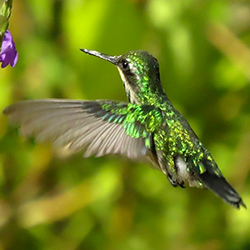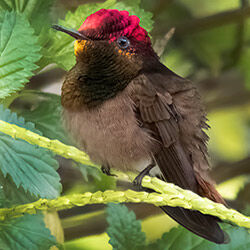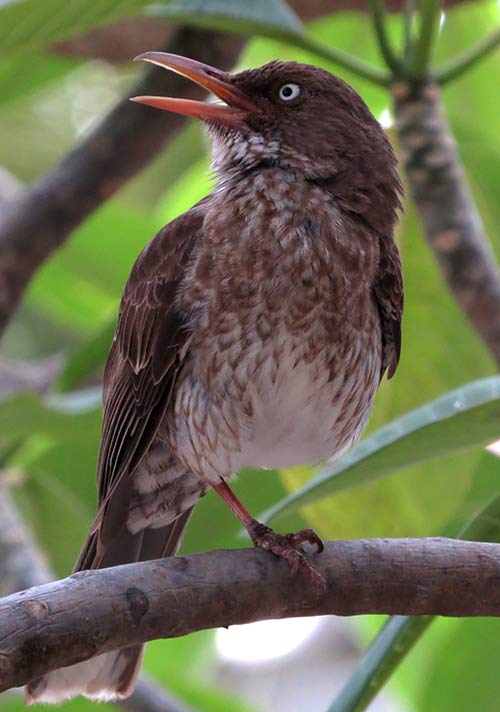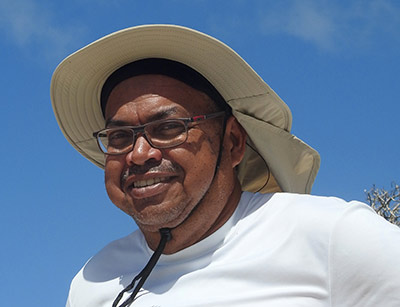Hummingbird Garden Sits
Available as an included option to your birding tour
About the Hummingbird Garden Sits.
The Garden
Relax with comfortable seating in Adirondack chairs. A well-visited birdbath and extensive feeder attract many species to forage, drink, or bathe. The best times for garden sits are in the later afternoon (generally 3:30 through 5:30 PM).
Hummingbirds visit the garden from sunrise through sunset, but the later afternoon hours provide the best opportunities for viewing both species of hummingbirds as well as other Bonaire garden birds. The garden is filled with a variety of natural vegetation with flowers and which attracts both of Bonaire’s hummingbirds.
Bonaire’s Hummingbird Species
The Blue-tailed Emerald Hummingbird
The Blue-tailed Emerald is Bonaire’s smaller hummingbird and is often found in conjunction with the Ruby-Topaz in many flowering gardens on the island.
This hummingbird is 7.5 cm (3 inches) long and weighs 2.6 g (.09 ounces). The black bill is relatively short and straight. The male has a brilliant green plumage, with white thighs and a dark metallic blue tail. The female is generally smaller than the male and also differs as it has grey-white underparts, a blackish ear patch, a short white supercilium/post-ocular streak, and white-tipped outer tail feathers.
The song is a pleasant twittering, and the call of this species is a pebbly tsip.

Blue-tailed Emerald
(Chlorostilbon mellisugus)
Diet: Nectar and insects
Breeding: Lays 2 eggs
Status: Least Concern
The Ruby-topaz Hummingbird
The Ruby-topaz Hummingbird is the larger of Bonaire’s two hummingbirds, and it can be found in many Bonaire gardens or other areas where there are flowers where it feeds on nectar. It will also eat small insects. The male Ruby-topaz will perch conspicuously and defend its territory aggressively, often chasing off the smaller Blue-tailed Emerald Hummingbird. The call of this species is a high-pitched tsip.
The Ruby-topaz is 8.1 cm (3.19 inches) long and weighs 3.5 g (.12 ounces). Compared to most other hummingbirds, the almost straight, black bill is relatively short.
The male has green-glossed dark brown upperparts. The crown and nape are glossy red, and the throat and breast are brilliant golden-orange. The rest of the underparts are brown, and the chestnut tail is tipped black. The male often looks very dark, until he turns and the brilliant colors flash in the sunlight.

Ruby-Topaz
(Chrysolampis mosquitus)
Diet: Nectar and some small insects
Breeding: Lays 2 eggs
Status: Least Concern
The female ruby-topaz hummingbird has bronze-green upperparts and pale grey underparts. The tail is chestnut with a dark subterminal band and a white tip. Juvenile females are similar to adult females, but with a white-tipped dusky-brown tail. Juvenile males resemble the juvenile female, but with a variable amount of iridescent orange to the throat.
Other birds you may expect to see.
Other species visit the garden as well. It is common to see Tropical Mockingbirds, Pearly-eyed Thrashers (Bonaire has an isolated population), Yellow-shouldered Parrots, Brown-throated Parakeets, Bananaquits, Saffron Finches, Venezuelan Troupials, Bare-eyed Pigeons, Eared Doves, and White-tipped Doves.
Occasionally, Yellow Warblers, Carib Grackles, Scaly-naped Pigeons, or Yellow Orioles make an appearance.
Riding thermals high in the sky one may find, depending upon the season, Ospreys, Magnificent Frigatebirds, Crested Caracaras, and Laughing Gulls.
What to bring for your Garden Sit:
Bonaire’s tropical sun may be overly bright for many. Although the garden does have shade, if you are susceptible to sunburn, then consider bringing a big floppy hat to shade your face and the back of your neck. Sunglasses may also assist with glare from the sun.
A lightweight long‐sleeve shirt, such as a rash guard, is recommended to avoid sunburn. If you have uncovered skin, do be sure to wear a reef‐safe sunscreen.
In most cases, annoying insects (mosquitoes, gnats, or no‐see‐ums) are not a problem. However, on days of light wind, they can become a nuisance. Bug spray will be available, but if you have a favorite brand, do pack it. If you are visiting during the light‐wind months of September and October, it is also recommended to pack a bandana, which can be placed over the nose and mouth if the insects are overly annoying.
If you plan on photographing, please bring your longest lens capability. All types of cameras, even smartphones, can be used on the garden sits, but being able to zoom in will definitely enhance your images. A camera that has fast focusing capabilities will definitely be of use when photographing hummingbirds.
The maximum is four persons per garden sit so that our presence does not scare the birds away. Generally, we need to sit quietly for about ten minutes, and then the birds will begin to visit the garden. The garden sit can be included in a custom tour, or as an included component to any of the tours. If you desire a garden sit as part of your tour, please advise Susan when booking and she can inform you of options.
Please note that the garden sits are conducted in English.
Get In Touch
Get in touch with Susan to check availability for the dates you are visiting Bonaire.
Consent: By using this form you agree with the storage and handling of your data by this website.





